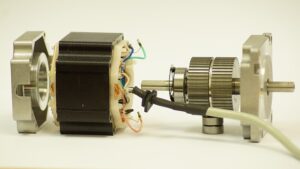Servo Motors
Servo motors are closed loop motors which operate by a commanded signal from the drive or amplifier. They can come in many different design styles from slotless to slotted and more. Servo motors allow for precise control of position, velocity, and acceleration. These motors are typically low pole count motors ultimately requiring them to be run via a closed loop process. Servo motors move in alignment with the commanded signal and check for errors with where the programmed signal says the motor shaft should be versus where the motor shaft actually is positioned. Servo motors will adjust shaft position based on this error calculation dynamically to ensure proper position/velocity/torque. Servo motors can run much faster than stepper motors too. Servo motors also deliver more consistent torque across the speed range of the motor. From 0 RPM to base speed for that motor, the motor will deliver constant torque. From base speed to the motor’s max speed, the power output of the motor will be constant. Up to the base speed of the motor, it will adjust power pulled from the drive based on the error signal to stay at the commanded position, velocity, or torque – this is the closed loop process. Think of a parent closely monitoring their child and ensuring that the child is actually doing what they were told to do (closed loop).
Servo Motors are a better choice for systems requiring:
- high speed
- high acceleration
- high accuracy
- high torque at high speed


Stepper Motors
Like servo motors, stepper motors consist of a rotor with permanent magnets and a stationary stator that carries the windings. As the current moves through the stator windings it generates a magnetic field which interacts with the magnets of the rotor ultimately resulting in pushing the pole and rotating the motor. Stepper motors are generally high pole count motors (generally 50 poles or more). The amplifier energizes each pole in order so that the rotor turns in a series of increments or steps. These moves can be done in full steps, or fractions of steps for the motor resulting in microstepping technologies. The key benefit of stepper motors is that they generally run open-loop. This benefit eliminates the cost and complexity of encoders or resolvers. Another benefit of running in an open loop scenario is the lack of servo dither. In a closed loop system the motor continually dithers around the final encoder position as it’s always correcting for the command signal, stepper motors do not have that dither and stop in final position (even if the final position is well off the commanded position). The challenge of stepper motors is their speed and torque curve limitations. Stepper motors generate maximum torque at zero speed then torque falls off quickly as speed increases. Stepper motors can be used in a quasi-closed loop system. A closed loop stepper system will only verify position at move completion, and requires full power throughout the move. An open loop stepper system will not verify the move. In an open loop system scenario, think of a parent telling a child to do something and the child then goes to do it without a parent checking on it actually being done (open loop).
Stepper motors are good solutions for applications with:
- low speed
- low acceleration
- low accuracy requirements
- Space constraints
- Cost constraints
| Motor Type | Pros | Cons | Typical Applications |
|---|---|---|---|
| Servo Motors |
|
|
Robotics, Factory Automation, Electric vehicles |
| Stepper Motors |
|
|
Lab equipment, ATM’s, Low cost 3D printers |